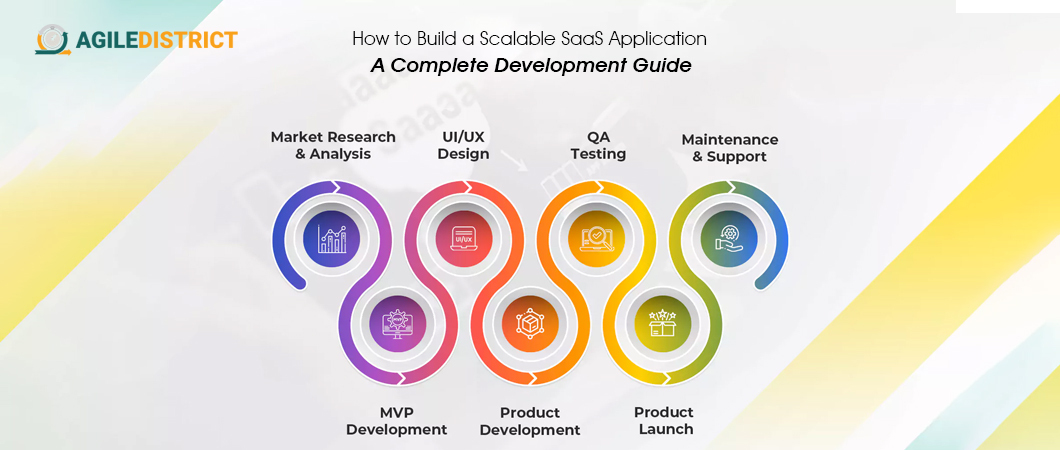The SaaS (Software as a Service) model has exploded in popularity—and it’s not just hype. From small startups to tech giants, businesses are embracing SaaS for its cost-efficiency, accessibility, and ability to scale globally. With cloud infrastructure maturing, the scalability of SaaS products has become both a necessity and a differentiator in the market.
But scalability isn’t automatic. It requires strategic planning, the right architecture, and a deep understanding of user behavior. At Agile District, we help businesses navigate these waters with proven expertise in saas application development. This comprehensive guide will show you how to build a SaaS application that doesn’t just launch—it thrives.

Understanding SaaS Application Development
So what exactly does saas application development entail? A SaaS app is a cloud-hosted software solution delivered to users over the internet—usually via a subscription. Unlike traditional software, it’s centrally maintained and updated, making it easier to manage and scale. A few defining traits of SaaS include:- Subscription model (monthly/annual plans)
- Multi-tenancy (single codebase for multiple users)
- Automatic updates (users always get the latest version)
- Cloud hosting (scalable infrastructure)
What Makes SaaS Scalable?
When we say “scalable,” we mean your app can grow with your users—without sacrificing performance or breaking the bank. Let’s explore what makes SaaS truly scalable:- Cloud-Native Infrastructure: Hosting on AWS, Azure, or Google Cloud allows you to auto-scale resources based on demand. Your app can handle 100 or 100,000 users seamlessly.
- Stateless Components: Building services that don’t store session data allows for easy horizontal scaling.
- Load Balancers: Efficiently distribute traffic to ensure consistent response times.
- Asynchronous Processing: Helps your app handle long-running tasks (like video rendering or reports) without slowing the UI.
Why Choosing the Right SaaS App Development Company Matters
You wouldn’t build a skyscraper with a backyard contractor, right? The same logic applies here. Partnering with a specialized saas app development company like Agile District brings immense benefits:- Strategic Discovery: We align your product goals with the right architecture and business model.
- Experienced Teams: Our developers, designers, and cloud architects bring SaaS-specific knowledge.
- Time-to-Market Advantage: We use agile sprints and devops practices to ship fast without cutting corners.
- Post-Launch Growth Support: We don’t disappear after launch—we help scale, monitor, and evolve your app.
Core Stages of SaaS Application Development
Here’s a closer look at the roadmap from idea to live product:Ideation & Market Validation
You start with a brilliant idea. But is there a real need? This stage involves market research, competitor analysis, and identifying your unique value proposition.Planning & Architecture
We define your SaaS app’s modules, user types, and data flows. Wireframes and mockups help visualize the end-product while identifying potential user friction early.MVP Development
An MVP (Minimum Viable Product) is a lean version of your app with only essential features. It’s perfect for early feedback and investor interest.Full Product Development
Based on user input from the MVP, we expand the feature set—adding payment systems, analytics, integrations, and admin controls.Testing, Launch & Feedback Loop
Quality assurance is critical. We test functionality, performance, and security before rolling out your app. Post-launch, we analyze real user data for improvements. Each step is a building block in our saas application development process—methodical, agile, and always user-first.Tech Stack for Building Scalable SaaS Apps
Picking the right tools is like choosing the right fuel for your car—you need the best performance for the journey ahead. Here’s a modern tech stack we often use at Agile District: Frontend Technologies:- React.js — dynamic UIs with component-based architecture
- Next.js — SSR and static site generation for lightning performance
- Node.js — fast, event-driven architecture
- Django — scalable and secure for complex data-heavy apps
- NestJS — enterprise-ready framework for TypeScript fans
- PostgreSQL — structured, scalable, ACID-compliant
- MongoDB — great for unstructured data and fast prototyping
- Redis — caching for high-speed performance
- Docker — containerization for reproducible builds
- Kubernetes — auto-scaling and orchestration
- AWS & Azure — battle-tested for scalability and uptime
Security and Compliance in SaaS Apps
Security is non-negotiable—especially when handling user data, financial transactions, or healthcare information. At Agile District, our security-first approach includes:- End-to-end Encryption: Protect data at rest and in transit
- OAuth 2.0 & JWT Authentication: Secure login and access management
- Role-Based Access Control (RBAC): Limit feature access by user roles
- Compliance with GDPR, HIPAA, CCPA: Essential for legal protection and user trust
Performance Optimization & Load Testing
Performance is the unsung hero of good UX. Users bounce fast when apps lag. We ensure peak performance using:- Caching Strategies: Redis and CDN caching for snappy experiences
- Database Indexing: Optimize slow queries for faster data retrieval
- Lazy Loading: Load assets only when needed
- Load Testing Tools: JMeter, Gatling, and LoadRunner for simulating real-world usage
Scaling for Future Growth: Tips from Agile District
Growth is exciting—but if your app can’t handle it, it’s a problem. Here are our pro tips:- Use Feature Flags: Roll out features to subsets of users
- Modularize the Codebase: Separate services for easy updates and scaling
- Automate CI/CD: Frequent releases with zero downtime
- Optimize Data Storage: Clean up stale data and archive intelligently
- Track Key Metrics: DAU, MAU, churn, retention, and load performance